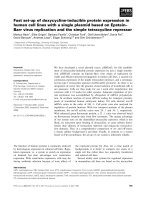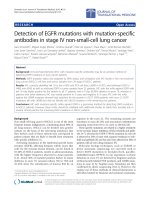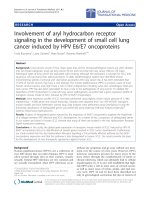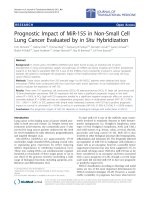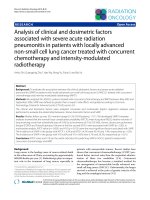Independent prognostic value of hypoxia-inducible factor 1-alpha expression in small cell lung cancer
Bạn đang xem bản rút gọn của tài liệu. Xem và tải ngay bản đầy đủ của tài liệu tại đây (774.14 KB, 6 trang )
Int. J. Med. Sci. 2017, Vol. 14
Ivyspring
International Publisher
785
International Journal of Medical Sciences
2017; 14(8): 785-790. doi: 10.7150/ijms.19512
Research Paper
Independent Prognostic Value of Hypoxia-inducible
Factor 1-alpha Expression in Small Cell Lung Cancer
Chang-Sheng Lin1,2, Tu-Chen Liu3, Ming-Tsung Lee4, Shun-Fa Yang1,5,, Thomas Chang-Yao Tsao6,7,
1.
2.
3.
4.
5.
6.
7.
Institute of Medicine, Chung Shan Medical University, Taichung, Taiwan
Department of Chest Medicine, Show Chwan Memorial Hospital, Changhua, Taiwan
Department of Chest Medicine, Cheng-Ching General Hospital, Taichung, Taiwan
Research Assistant Center, Chang Hua Show Chwan Health Care System, Changhua, Taiwan
Department of Medical Research, Chung Shan Medical University Hospital, Taichung, Taiwan
Division of Chest, Department of Internal Medicine, Chung Shan Medical University Hospital, Taichung, Taiwan
School of Medicine, Chung Shan Medical University, Taichung, Taiwan
Corresponding author: Thomas Chang-Yao Tsao, M.D., Ph.D. Division of Thoracic Medicine, Chung Shan University Hospital and Chung Shan Medical
University, Taichung, Taiwan. Tel: +886-4-24730022 ext. 11020. Fax: +886-4-24759950. E-mail: Or Shun-Fa Yang, PhD. Institute of
Medicine, Chung Shan Medical University, Taichung, Taiwan. E-mail:
© Ivyspring International Publisher. This is an open access article distributed under the terms of the Creative Commons Attribution (CC BY-NC) license
( See for full terms and conditions.
Received: 2017.02.06; Accepted: 2017.05.17; Published: 2017.07.18
Abstract
Hypoxia is an important factor in tumor angiogenesis, metastasis, and resistance to chemotherapy
or radiotherapy, and may be an indicator of poor prognosis. The transcription factor
hypoxia-inducible factor 1 (HIF-1) is the key regulator of the hypoxic state. This study was
designed to evaluate the prognostic value of HIF-1α expression in small cell lung cancer (SCLC).
Forty-three paraffin-embedded biopsy materials were examined using immunohistochemistry.
Our results indicated that the expression of HIF-1α was high in males, and patients with poor
Eastern Cooperative Oncology Group (ECOG) performance status and metastases. To elucidate
the prognostic value of HIF-1α expression, Kaplan-Meier analysis was carried out and the results
showed that patients with high HIF-1α expression had a poorer prognosis than patients with low
expression of HIF-1α. After adjusting clinical parameters by the Cox proportional hazards model,
our results demonstrated that high HIF-1α expression is an independent prognostic factor for
SCLC with a 39.2-fold risk of death (p<0.003). In conclusion, we have provided evidence that
HIF-1α expression has significant value in predicting survival of patients with SCLC and is an
independent prognostic factor beyond ECOG performance and metastasis status.
Key words: small cell lung cancer, hypoxia-inducible factor-1 alpha, immunohistochemistry, survival
Introduction
Lung cancer is the leading cause of
cancer-related death worldwide. Human lung cancers
are classified into small cell lung cancer (SCLC) and
non-small cell lung cancer (NSCLC) groups, the latter
consisting of adenocarcinoma, squamous cell
carcinoma, bronchioalveolar carcinoma, and large-cell
carcinoma. Despite advances in lung cancer therapy,
the average 5-year survival rate is only 18% [1].
Between 15% and 25% of all lung cancer cases are
classified histologically as SCLC, which is
characterized by rapid growth and a high metastatic
potential [2]. The natural history of SCLC reveals
earlier dissemination and higher mortality than that
of NSCLC. In general, SCLC is considered to be a
systemic disease, even if SCLC appears to be confined
to the chest at the time of diagnosis. Patients with
SCLC have decreased longevity and are rarely cured
with the currently available therapies.
According to the two-stage system of the
Veterans Administration Lung Cancer Group
(VALG), SCLC is classified as extensive (ED-SCLC)
and limited disease (LD-SCLC). The pre-treatment
prognostic factors that consistently predict prolonged
survival include good performance status, female
Int. J. Med. Sci. 2017, Vol. 14
gender, and LD-SCLC. The median survival for
untreated LD-SCLC and ED-SCLC patients is 4-6
months and 5-9 weeks, respectively. Of note, the
survival of SCLC patients could be improved
significantly with effective therapy [3].
Hypoxia is a critical factor that impacts cell
proliferation, survival, angiogenesis, immunosurveillance, metabolism, tumor invasion, and metastasis,
and is associated with a worse prognosis for cancer
patients [4-7]. Transcription factor hypoxia-inducible
factor 1 (HIF-1) is the key regulator responsible for the
induction of genes that facilitate adaptation and
survival of cells, and the entireorganism, from
normoxia (~21% O2) to hypoxia (~1% O2) [8, 9]. There
are two main characteristics of solid tumors
(neovascularization and increased glycolysis), which
represent adaptations to a hypoxic microenvironment
and are correlated with tumor invasion, metastasis,
and lethality. HIF-1α overexpression has been
previously reported to be associated with a poor
prognosis in breast, oropharyngeal, and cervical
cancers [10-13]. Moreover, the correlation between the
presentation of HIF-1α and the prognosis of NSCLC
has been analyzed [14-16]. Specifically, Giatromanolaki showed that HIF-1α is associated with VEGF
expression, but is not significantly correlated with
NSCLC prognosis [14], and Swinson had revealed
that HIF-1α expression is associated with a poor
prognosis [15]. Moreover, a systematic review also
reports that HIF-1α might serve as important factors
in evaluating prognosis of lung cancer [16]. There are
no data, however, showing an association between
HIF-1α expression and SCLC prognosis. In the current
study, we examined HIF-1α protein expression in 43
SCLC specimens using immunohistochemistry and
evaluated the role of HIF-1α in influencing the
prognosis of SCLC.
Materials and methods
Patient and study design
The original biopsy materials were obtained
from bronchoscopic or computer tomography-guided
needle specimens. Archival paraffin-embedded
biopsy materials from 43 SCLC (all patients received
at least 2 courses of chemotherapy with cisplatin [25
mg/m2/day] and etoposide [100 mg/m2/day] for 3
days monthly) were retrieved and 4-μm tissue
sections were cut on slides. Histologic diagnoses were
made using hematoxylin and eosin (H&E) staining.
The Institutional Review Board of Show Chwan
Memorial Hospital approved the study proposal (IRB
No. 1000909).
786
Immunohistochemistry for HIF-1α
Slide sections were dewaxed with xylene and
rehydrated through a gradient concentration of
alcohol. After the sections were microwaved, the
primary monoclonal HIF-1α antibody (SC-53546,
dilution 1:50; Santa Cruz Biotechnology, Inc., Santa
Cruz, CA, USA) was applied as described previously
[17]. The secondary antibody was applied at room
temperature for 15 min after twice-washing in water
and Tris buffer for 5 min. Then, the slide was washed
again using the abovementioned procedures. The
slides were then incubated with avidin-HRP for 30
min and washed again. The color was developed with
3, 3’-diaminobenzidine solution (DAB) for 5 min.
Gill’s hematoxylin was used for counterstaining and
the staining time was < 1 min. The stained slide was
immersed in 95% alcohol, then in absolute alcohol for
5 min. Negative controls were not exposed to primary
antibody. The stained slides were cover-slipped and
observed under light microscopy at an optical power
of × 40.
Scoring of HIF-1α expression
The immunohistochemical results for HIF-1α
protein were examined and the scored results were
assessed by three board-certified pathologists. Every
slide was given a score according to the intensity of
the nuclear staining, as follows: no staining or nuclear
staining in < 1% of the cells, negative (-); nuclear
staining in 1%-10% of cells, mild (+); nuclear staining
in 10%-50% of cells, moderate (++); and nuclear
staining in > 50% of cells, strong (+++). In the current
study, moderate (++) and strong scores (+++) were
considered to be high immunostaining and negative
(-) and mild scores (+) were considered to be low
immunostaining.
Statistics
Fisher’s exact or chi-square test was applied for
statistical analysis. Survival curves were plotted using
the Kaplan-Meier method and statistical significance
was assessed using the log-rank test. Univariate
analysis was analyzed by the Cox proportional
hazards regression model and the statistical analysis
was performed using SPSS for Windows (version 12;
SPSS, Inc., Chicago, IL, USA). AP < 0.05 was
considered to be statistically significant.
Results
Patient Characteristics
Forty-three SCLC patients were included in this
retrospective study (Table 1). The median age of the
patients was 70 ± 9.82 years (range, 47-87 years), and
male patients were predominant (95.3%). Of the
Int. J. Med. Sci. 2017, Vol. 14
787
Figure 1. Representative of HIF-1α protein immunostaining in paraffin sections of SCLC tumors. (a). low immunostaining (40X). (b). high. immunostaining (40X).
patients, 93% were smokers or ever-smokers. The
Eastern Cooperative Oncology Group (ECOG)
performance status score of all patients was < 3. As
expected, a high distant metastases rate was common
at the time of diagnosis of SCLC (83.7%).
Table 1. Relationships between clinical parameters and HIF-1α
expression in 43 SCLC patients
Characteristics
Age (years)1 (range)
<70
≧70
Gender
Female
Male
ECGO performance
status
0
1
2
3
Smoking status
Never smoked
Current smoker or ever
smoked
Distant metastasis
Negative
Positive
No. of
cases
70±9.82
(47-87)
18
25
Low (%)
n=17
High (%)
n=26
p2
7 (39)
10 (40)
11 (61)
15 (60)
0.941
2
41
2 (100)
15 (37)
0 (0)
26 (63)
0.0493
3
13
16
11
3 (100)
12 (92)
2 (13)
0 (0)
0 (0)
1 (8)
14 (87)
11 (63)
<0.001
3
40
1 (33)
16 (40)
2 (67)
24 (60)
1.0003
7
36
7 (100)
10 (28)
0 (0)
26 (72)
0.0013
. Mean ± SD
. Chi-square test for categorical variables
3. Fisher's exact test
1
2
HIF-1α expression scores
Representative immunohistostaining results of
HIF-1α are shown in Figure 1. Low and high HIF-1α
immunostaining expression is shown in Figure 1 (a)
and (b), respectively. Of the 43 cases analyzed, the
levels of HIF-1α expression were as follows: 7 cases
(16.3%) with negative staining (-); 10 cases (23.3%)
with mild staining (+); 9 cases (20.9%) with moderate
staining (++); and 17 cases (39.5%) with strong
staining (+++). In the current study, 26 cases (60.4%)
had high expression of HIF-1α.
Relationships between HIF-1α expression and
clinical pathologic parameters in SCLC
patients
Among the studied clinic-pathologic parameters,
including age, gender, ECOG performance status,
smoking status, and distant metastases, statistically
significant associations between HIF-1α expression
and gender, smoking status, ECOG performance
status, and distant metastases were observed, as
shown in Table 1 (p=0.049 for gender; p<0.001 for
ECOG performance status; and p=0.001 for distant
metastases). There were two female patients in the
study
with
low
HIF-1α
immunostaining.
Interestingly, HIF-1α expression was concordant with
the ECOG performance status (p<0.001). Patients with
a poor ECOG performance status had high HIF-1α
expression. Furthermore, HIF-1α was expressed in 0
and 72% of distant metastasis-negative and -positive
patients, respectively. Our results suggest that ECOG
performance status and distant metastases are highly
corrected with HIF-1α expression.
Prognostic value of HIF-1α expression in SCLC
patients
The median survival of all patients was 167 ±
14.42 days (95% CI, 138.72 - 195.27 days). According to
the results of immunohistostaining, the median
survival of the low- and high-staining groups was 311
± 12.35 days (95% CI, 286.8 - 335.2 days) and 102 ± 15.3
days (95% CI, 72.02 - 131.92 days), respectively. The
association of HIF-1α expression with various
clinic-pathologic parameters with patient survival
Int. J. Med. Sci. 2017, Vol. 14
788
was determined by univariate analysis. As expected
and as shown in Table 2, poor ECOG performance
status and distant metastasis-positive patients had
shorter survival than good ECOG performance status
and distant metastasis-negative patients (p<0.001 for
ECOG performance status; and p<0.001 for distant
metastasis). The results showed that patients with
high HIF-1α expression had significantly shorter
survival than patients with low HIF-1α expression
(Table 2). Figure 2 shows that patients who express
HIF-1α had significantly shorter overall survival
based on Kaplan-Meier survival curves (log-rank,
p<0.001). Moreover, Cox regression analysis data
indicated the patients with high HIF-1α expression
had a significantly worse overall survival than
patients with low HIF-1α expression (p=0.003, Table
3). Among the study cases, the risk ratio (RR) of age,
ECOG performance status, and distant metastases
were 2.372-, 4.286-, and 11.858-fold, respectively
(p=0.025 and 95% CI, 1.114-5.049 for age; p=4.286 and
95% CI, 0.726-25.303 for ECOG performance status;
p=0.003 and 95% CI, 2.259-62.243 for distant
metastases). Interestingly, the RR of patients with
high HIF-1α expression was 39.207-fold patients with
low HIF-1α expression. The RR of HIF-1α expression
(39.207-fold) was higher than the RR of distant
metastases (11.858-fold). Thus, HIF-1α expression is a
more effective independent prognostic factor than
stage status in patients with SCLC.
Table 2. Univariate analysis of influences of clinical characteristics
on overall survival duration of SCLC patients
Characteristics
Age (years)
<70
≧70
Gender
Female
Male
ECGO performance status
0
1
2
3
Smoking status
Never smoked
Current smoker or ever
smoked
Distant metastasis
Negative
Positive
HIF-1α immunostaining
Low
High
No. of
cases
Median survival
(days)
Log-rank1
18
25
183
167
0.3646
2
41
288
167
0.666
3
13
16
11
537
308
161
61
<0.001
3
40
181
167
0.614
7
36
386
156
<0.001
17
26
311
102
<0.001
1. Log-rank p-values for categorical variables were statistically analyzed by
Kaplan-Meier test.
Table 3. Cox regression analysis of various potential prognostic
factors in SCLC patients1
Variables
HIF-1α
immunostaining
Age
Gender
ECGO
performance status
Smoking status
Distant metastasis
RR
Unfavorable/Favorable
39.207 high/low
p
95% CI
0.003 3.355-458.219
2.372 ≧70/<70
0.824 male/female
4.286 3, 4/1, 2
0.025 1.114-5.049
0.868 0.084-8.080
0.108 0.726-25.303
1.110 current or ever
smoked/never smoked
11.858 positive/negative
0.874 0.305-4.037
0.003 2.259-62.243
. Adjusted for age, sex, ECGO performance status, smoking and distant metastasis
status.
1
Figure 2. Kaplan-Meier survival of 43 SCLC patients with high and low HIF-1α
immunostaining.
Discussion
HIF-1α is an important regulator in tumor
angiogenesis and distant metastases. HIF-1α is
overexpressed in many types of human cancers and is
associated with a poor prognosis. HIF-1α expression
was demonstrated in 84% of the patients with SCLC
in the current study. Also, patients with a higher level
of HIF-1α expression had significantly shorter
survival times and more distant metastases than
patients with a low level of HIF-1α expression.
HIF-1α expression has been reported to be
increased in 13 types of cancer, including lung,
prostate, breast, and colon carcinomas, which are the
leading causes of cancer mortality in the US [18].
HIF-1α overexpression was demonstrated in 55.8% of
patients with NSCLC in one study, and HIF-1α
protein was overexpressed in 66.7% (6/9) of patients
with SCLC in another study [19, 20]. In the current
Int. J. Med. Sci. 2017, Vol. 14
study, HIF-1α was detected in 83.7% (36/43) of
patients with SCLC, 60.4 % (26/34) of whom had high
expression. HIF-1α expression is more prominent in
patients with SCLC than NSCLC, which is consistent
with clinical findings. This observation might explain
why SCLC is more malignant and metastasizes
earlier.
The prognostic significance of HIF-1α expression
has been evaluated in several solid tumors. Increased
HIF-1α expression has been reported to be associated
with a poor prognosis in lymph node-positive breast
cancer and non-metastatic oropharyngeal cancer [10,
11]. Two studies evaluated the relationship between
the presentation of HIF-1α and the prognosis in
patients with NSCLC. One study showed that HIF-1α
protein is associated with expression of vascular
endothelial growth factor (VEGF), platelet-derived
endothelial cell growth factor, and basic fibroblast
growth factor in patients with NSCLC, but was not
significantly associated with prognosis [14]. The other
study reported that higher HIF-1α expression is
associated with a poorer prognosis [15]. Low HIF-1α
expression in ED-SCLC patients who were treated
with frontline platinum-based chemotherapy had
better overall survival rate [19]. Luan reported that
HIF-1α and HIF-2α expression is related to shorter
overall survival, which was similar to our results;
however, only HIF-2α expression has been
recommended to be an independent prognostic
marker [20].
Inhibition of HIF-1α activity has become an
effective anti-tumor therapy for various tumors [21].
Moreover, Bryant et al. described that targeting
hypoxia maybe important in the development of
novel therapies for SCLC [22]. Cisplatin and etoposide
are usually used as first-line chemotherapy for SCLC,
and can significantly prolong survival; however, most
SCLC patients treated with first-line chemotherapy
will eventually relapse. Topotecan is commonly used
as second-line chemotherapy for SCLC. In an in vitro
study, topotecan reduced the hypoxic up-regulation
of HIF-1α, and reduced the HIF-1 transcriptional
response to hypoxia by inhibiting the HIF-1
transcriptional activation pathway through inhibition
of HIF-1α translation [23]. Lund reported that patients
with very hypoxic tumors might benefit, in particular
from topotecan treatment, and the anti-HIF effect of
topotecan should be taken into consideration in these
patients [24]. Our study presented a wide range of
survival time (18-602 days) among the 43 SCLC
patients. All of our patients received cisplatin and
etoposide as first-line chemotherapy. Therefore,
topotecan might be considered as first-line
chemotherapy in SCLC patients with high HIF-1α
expression to achieve better survival.
789
In summary, we showed HIF-1α expression in
most patients with SCLC. In addition, patients with a
higher level of HIF-1α expression had significantly
shorter survival times and more distant metastases in
the current study. Expression of HIF-1α could be a
more effective independent prognosis factor than
ECOG performance and distant metastasis in SCLC
patients. Based on our data, we recommend that
SCLC patients with high HIF-1α expression be treated
with a drug that inhibits HIF-1α (topotecan), which
we predict will lead to better survival.
Acknowledgments
This study was supported by the grant from
Chang Shan Medical University and Hospital
(CSH-2011-C014).
Competing Interests
The authors have declared that no competing
interests exist.
References
[1]
[2]
[3]
[4]
[5]
[6]
[7]
[8]
[9]
[10]
[11]
[12]
[13]
[14]
[15]
[16]
[17]
Siegel RL, Miller KD and Jemal A. Cancer statistics, 2016. CA Cancer J Clin
2016; 66: 7-30.
Howe HL, Wingo PA, Thun MJ, et al. Annual report to the nation on the status
of cancer (1973 through 1998), featuring cancers with recent increasing trends.
J Natl Cancer Inst 2001; 93: 824-842.
Zhang X, Yu J, Zhu H, et al. Consolidative thoracic radiotherapy for extensive
stage small cell lung cancer. Oncotarget 2017;
Ruan K, Song G, Ouyang G. Role of hypoxia in the hallmarks of human cancer.
J Cell Biochem 2009; 107: 1053-1062.
Chen MK, Chiou HL, Su SC, et al. The association between hypoxia inducible
factor-1alpha gene polymorphisms and increased susceptibility to oral cancer.
Oral Oncol 2009; 45: e222-226.
Hsiao PC, Chen MK, Su SC, et al. Hypoxia inducible factor-1alpha gene
polymorphism G1790A and its interaction with tobacco and alcohol
consumptions increase susceptibility to hepatocellular carcinoma. J Surg
Oncol 2010; 102: 163-169.
Lin CW, Yang WE, Lee WJ, et al. Lipocalin 2 prevents oral cancer metastasis
through carbonic anhydrase IX inhibition and is associated with favourable
prognosis. Carcinogenesis 2016; 37: 712-722.
Semenza GL. HIF-1 mediates metabolic responses to intratumoral hypoxia
and oncogenic mutations. J Clin Invest 2013; 123: 3664-3671.
Semenza GL. Hypoxia-inducible factors: coupling glucose metabolism and
redox regulation with induction of the breast cancer stem cell phenotype.
EMBO J 2017; 36: 252-259.
Schindl M, Schoppmann SF, Samonigg H, et al. Overexpression of
hypoxia-inducible factor 1alpha is associated with an unfavorable prognosis in
lymph node-positive breast cancer. Clin Cancer Res 2002; 8: 1831-1837.
Aebersold DM, Burri P, Beer KT, et al. Expression of hypoxia-inducible
factor-1alpha: a novel predictive and prognostic parameter in the radiotherapy
of oropharyngeal cancer. Cancer Res 2001; 61: 2911-2916.
Peng X, Gong F, Chen Y, et al. Autophagy promotes paclitaxel resistance of
cervical cancer cells: involvement of Warburg effect activated
hypoxia-induced factor 1-alpha-mediated signaling. Cell Death Dis 2014; 5:
e1367.
Martinho O, Silva-Oliveira R, Cury FP, et al. HER Family Receptors are
Important Theranostic Biomarkers for Cervical Cancer: Blocking Glucose
Metabolism Enhances the Therapeutic Effect of HER Inhibitors. Theranostics
2017; 7: 717-732.
Giatromanolaki A, Koukourakis MI, Sivridis E, et al. Relation of hypoxia
inducible factor 1 alpha and 2 alpha in operable non-small cell lung cancer to
angiogenic/molecular profile of tumours and survival. Br J Cancer 2001; 85:
881-890.
Swinson DE, Jones JL, Cox G, et al. Hypoxia-inducible factor-1 alpha in non
small cell lung cancer: relation to growth factor, protease and apoptosis
pathways. Int J Cancer 2004; 111: 43-50.
Ren W, Mi D, Yang K, et al. The expression of hypoxia-inducible factor-1alpha
and its clinical significance in lung cancer: a systematic review and
meta-analysis. Swiss Med Wkly 2013; 143: w13855.
Lee SS, Tsai CH, Yang SF, Ho YC, Chang YC. Hypoxia inducible factor-1alpha
expression in areca quid chewing-associated oral squamous cell carcinomas.
Oral Dis 2010; 16: 696-701.
Int. J. Med. Sci. 2017, Vol. 14
790
[18] Zhong H, De Marzo AM, Laughner E, et al. Overexpression of
hypoxia-inducible factor 1alpha in common human cancers and their
metastases. Cancer Res 1999; 59: 5830-5835.
[19] Lee GW, Go SI, Cho YJ, et al. Hypoxia-inducible factor-1alpha and excision
repair cross-complementing 1 in patients with small cell lung cancer who
received front-line platinum-based chemotherapy: a retrospective study. J
Thorac Oncol 2012; 7: 528-534.
[20] Luan Y, Gao C, Miao Y, et al. Clinicopathological and prognostic significance
of HIF-1alpha and HIF-2alpha expression in small cell lung cancer. Pathol Res
Pract 2013; 209: 184-189.
[21] Semenza GL. Targeting HIF-1 for cancer therapy. Nat Rev Cancer 2003; 3:
721-732.
[22] Bryant JL, Meredith SL, Williams KJ, White A. Targeting hypoxia in the
treatment of small cell lung cancer. Lung Cancer 2014; 86: 126-132.
[23] Rapisarda A, Uranchimeg B, Scudiero DA, et al. Identification of small
molecule inhibitors of hypoxia-inducible factor 1 transcriptional activation
pathway. Cancer Res 2002; 62: 4316-4324.
[24] Lund EL, Hansen LT, Kristjansen PE. Augmenting tumor sensitivity to
topotecan by transient hypoxia. Cancer Chemother Pharmacol 2005; 56:
473-480.
